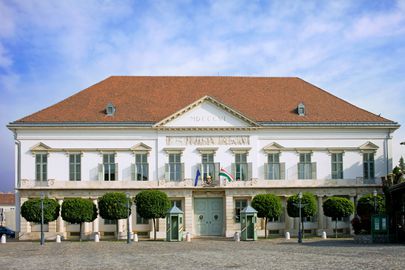

It was Count Vincent Sandor who first commissioned the building of Sándor Palace, in 1803, which still bears his prestigious family name. The plot of land he owned was conveniently situated right next to the Royal Palace. It was fully completed in 1806 and quite obviously, as a result of its close proximity to the Palace, was always going to be a prominent and important building with a significant role to play in the history of Hungary - and so far, it hasn’t been proved wrong. It is thought that the Hungarian architect Mihaly Pollack was responsible for the design which he based on the neoclassical style.
Curiously enough, it is not the old Count’s name that legend has preserved, but that of his son; Moric Sandor who was known as the ’The Devil’s Horseman’ due to his daring equestrian feats and ’colourful personality’.
The palace remained in the ownership of the Sandor family until 1831, when it came into the hands of the Pallavicini family. After it was sold to the State and this was when it became government property and the residence of Hungary’s Prime Ministers. Its first resident was Gyula Andrassy who occupied the building from 1867, and since then until the end of World War II a total of 19 Prime Ministers were to either hold office or reside here. Not all of them were in power long enough to be able to move in.
What’s more, the palace has not always had a happy history.
Pal Teleki, who was the Prime Minister at the time of the outbreak of WorldWar II, was to commit suicide in this building after Germany marched through Hungary to invade Yugoslavia. Four years later the building was bombed to pieces during the Siege of Budapest.
As well as being destroyed by artillery it was discovered after the fall of communism that most of the original furniture and fittings had either perished through neglect or found their way as war booty into the Soviet Union.
The palace was eventually reconstructed but this took several years and much of the work was based on photo and documentary evidence rather than first-hand knowledge. The palace as it stands nowis more of a rebirth which reflects its history, rather than a completely faithful restoration.
Today it is the formal residence of the President of the Republic of Hungary, however during the summer months it is possible to gain access and have a guided tour of the building.
But even if you do not get the opportunity to look inside it is still worth watching the changing of the guards outside the palace. This happens every hour during the day, and on the last Saturday of each month the changing of the guard is accompanied by military music. The choreography is quite complicated and definitely worth watching as the guards turn the rifles, salute and march up and down the square.
The palace is also right next to the funicular railway which transports visitors up and down the Castle District, as well as the huge bronze statue of the great Hungarian mythical Turul bird which overlooks the Danube. This impressive statue shows the falcon-like bird with its wings spread wide and in its talons is a sword. The Turul is hugely significant to Hungarians as it not just represents their nation’s power and will, but plays a big part in the story of how the Magyars actually came to settle in the Carpathian basin. It is a divine messenger, and it perches on top of the tree of life along with the other spirits of unborn children in the form of birds. The Turul became a symbol of power, strength, and nobility, and it is still used today on the coat of arms of the Hungarian Army, the Counter Terrorism Centre and the Office of National Security.